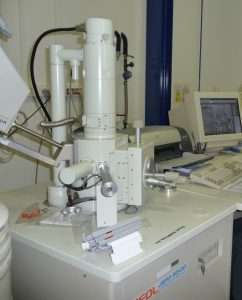Written by Microscopehunt Authority |
Explore the hidden creatures around you with a microscope! Watch tiny creatures come to life, learn about science, and take stunning close-up photos.

Scanning Electron Microscopes are highly sophisticated devices that give a look into the microscopic world in minute detail. They have really changed the approach to studying materials and biological specimens, as well as even tiny structures undetectable by the naked eye. This article will deal with the various applications of SEMs, their mode of operation, and their importance in scientific research and industry.
How Scanning Electron Microscopes Works
Before we look into how SEMs work and what they could possibly do, it becomes imperative to have a grasp of how scanning electron microscopes function. SEMs are unlike any conventional optical microscopes in doing so. The beam is focused upon the sample and scanned. The sample emits signals back as electrons contribute to their creation involved in the interaction with the specimen. As a consequence of the above, a broader view of the image is achieved on the basis of some embodied structure far into nanoscale. It is this ability of SEM’s high-resolution imaging that is really responsible for the slew of applications, from the analysis of the surface of a metal to the working out of the structure of a small insect.
Uses of Scanning Electron Microscopes
Scanning Electron Microscopes serve a multifactorial purpose. They aid scientists and engineers in the study of materials and biological structures while solving crimes. let us put it down on a larger perspective of SEM applicational field.
Materials Science
In material science, SEMs are used to study the properties associated with materials like metals, ceramics, plastics, and composites.
Analysing Defect in Metals:
SEMs allow researchers to look deep into tiny features of metals. They may find cracks, defects, or irregularities that can weaken the part. The need to develop stronger and safer materials for buildings, cars, and airplanes has made this study significant.
Material Composition Study:
The SEMs are also used to detect, by means of energy-dispersive X-ray spectroscopy (EDS), the elements that make up a specific material. This enables scientists to realize the fabrication of new materials and improvement on existing ones.
Biological Studies
Quite like plant studies in biology, SEMs are usually needed for the analysis of biological material on microscopic levels of observation.
Such a method is used for the study of living things in microbiological environments. Structures of cells and tissues will thus be analyzed.
Microorganisms:
SEMs are the mainstay in studying bacteria, viruses, and other tiny organisms. This provides conditions for developing medicines and vaccines.
Also, they allow studying the surfaces of leaves, roots, and flowers to understand how plants grow and interact with the environment.
Nanotechnology

Nanotechnology is the study of very small things. Thus SEM is most suitable for this study.
Study of Nanoparticles:
SEM is used in laboratories to study tiny particles that are used in medicine, electronics, and energy storage.
Nanomedicine: SEM plays a major role in the synthesis of nanoparticle-based drug delivery systems directed toward foremost diseased cells. This method results in effective therapies with fewer side effects.
Industrial Applications
The SEM is very widely used in the industries under various circumstances to upgrade the product and to resolve the issues.
Quality Control:
In the examination of commercial products, the SEM is used for quality inspection procedures. It is used in checking tiny parts in electronics, such as microchips.
Failure Analysis:
In the event of something breaking or malfunctioning, SEMS can find out the reason it broke. On the other hand, it can be upgraded into an improved design to avoid subsequent problems.
Environmental Science and Geology

Earth and within SEMs will also be analyzed for environmental sciences.
For Geological Analysis of Rocks and Minerals: SEM plays a role in the structural and compositional investigations of geological materials. This would also allow them to slowly understand how Earth has evolved over the periods.
Pollutants Study:
In environmental-science applications, they serve to examine tiny particles accumulating in air, water, or soil; this gives insight toward pollution, affecting the ecosystem.
Forensic Science
An SEM plays an important role in solving criminal acts.
Evidence Analysis: SEMs examine gunshot residue, fiber, paint chips, and hair. The technology assigns investigators clues and knowledge. It helps to piece the case together.
Identifying Suspects: Correlating evidence from a crime site with samples from a suspect, SEMs help to prove who was involved in the crime.
Advancements in SEM Technology
As the years have flown by, the SEM apparatuses have become even more powerful and suitable.
Environmental SEMs:
These allow scientists to look at the samples in their natural states without being prepared beforehand. They are especially useful in the study of living organisms.
Combining with Other Tools:
Modern SEMs can work in conjunction with an FIB and AFM, allowing greater detail studies and further information about the performance of your samples.
Conclusion
Scanning Electron Microscopes serve to provide terrific tools that magnify and enable one’s comprehension of the tiny world surrounding us. They find use in several fields: scientific and medical, industrial, and forensic inspections. As the technology keeps developing, SEMs shall continue to assist in making discoveries as well as solving relevant problems.
